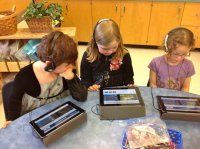Don’t Forget Professional Development for Students
Teachers spend countless hours learning new tools to use in class, but do they set aside any time for students to learn these new tools as well? Too often, we assume that students know all about this stuff because they are young and hip to the whole technology thing. That's one of the worst assumptions a teacher can make about a student. Assuming student skills can be a fast track to student failure.
The first time a student told me they didn’t have an email address and didn’t know how to attach files, it blew my mind. Shouldn’t all students know how to send email? Haven’t students been sending attachments for years? That revelation changed the way that I integrate technology into my classroom. I offer three tips on making student professional development a seamless part of your classroom.
1) Model
When I say model, I’m not suggesting you walk the catwalk in your classroom, but it’s still pretty close. Teachers need to show the class what they are doing and how they were able to do it. It can be a simple act like showing the class how to attach an email you are about to send to another student, or how to create a new line in an Excel sheet. These little show-and-tells give students the chance to see how things are done. Then they can take these modeling experiences and try them on the catwalk themselves.
2) Explore
This might be the toughest one, but it's important to work in an extra day for projects that will really let kids explore different tech options. I always provide more than one option to students when it comes to presenting their work in the hope that they'll stretch themselves. The only way your students will try new things is if they feel there's time to do something different. I have shown students Prezi and Pixton, and they loved them but would not have used these tools if I hadn’t given them time to explore on their own. It's also important to provide support and modeling as needed during the exploring phase. The more support the better.
3) Delegate
There are leaders all around us. One of a teacher's jobs is to help students see their own leadership qualities and put them in a position to be successful. There are some very tech savvy students out there who would make great teachers if given the chance to help. I always identify my "co-teachers" for various lessons. These are the people I can count on to provide support to their classmates when I’m working with other students. These co-teachers have the ability to relate to struggling students in a different way than I can, and they love being helpful. I wish I could provide support to all 30 students in a 48-minute class period, but it's not feasible all of the time. Delegating some of the support is an excellent way to keep everyone on the same page.
By integrating these three ideas into the classroom, students will get the support they need as they learn new tools to help them better understand the content in class. Engaging students in different forms of technology can be great, but assuming they are already experts in all things tech is the path to disaster. And we all want to avoid that path whenever possible.
How do you help students with the new tools you use in your class? Leave comments below so we can all learn and help our students.
